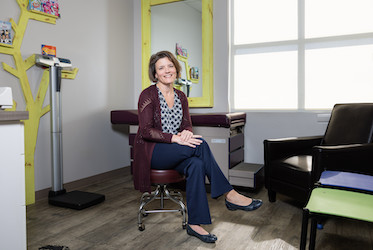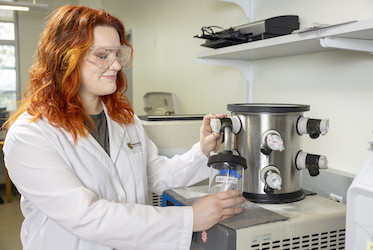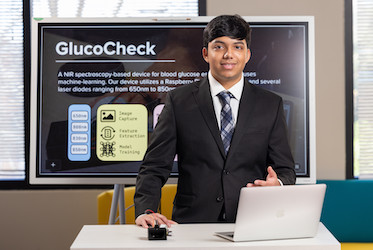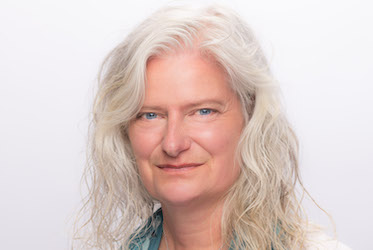
Research Computing Resources Support Complex Projects
KENNESAW, Ga. | Jun 11, 2020

Kennesaw State University is home to the High-Performance Computing (HPC) cluster, which supports various research projects conducted by faculty and students. The specialized technology resources and technical expertise are coordinated by a partnership between the Office of the Chief Information Officer (CIO) and the Vice President for Information Technology, as well as the Office of the Vice President for Research.
The HPC cluster is a collection of separate servers interconnected on an isolated, fast network. One main computer manages the users’ data and software and schedules user jobs across more than 50 individual computers that are performing the computational tasks. Currently, over 150 researchers use these nodes configured for central processing unit intensive computation, high memory computation and graphics processing unit computation.
This shared resource is freely available to all KSU faculty and their designees engaged in research activities. Researchers with grant awards can partner with University Information Technology Services (UITS) to acquire HPC nodes for either their sole access or inclusion into the general pool.
“My goal is to assist researchers in their use of computation resources able to construct, analyze and interpret their complex data. For me, supporting research could mean anything from offering individualized training to new users, to helping procure new software, to writing custom code for special projects,” said Tom Boyle, research computing coordinator in the Office of Research. “I am excited to be part of a service that is monitored and maintained by dedicated HPC staff members so KSU researchers can use their time to focus on their primary research.”
Andrew Hummel, assistant professor of nuclear engineering, is part of the Nuclear Energy, Science, and Engineering Laboratory (NESEL) at KSU. He is currently using the supercomputer in the development of a microreactor concept for deployment to remote areas.
He explained that microreactors are the size of a large trashcan and can produce several megawatts of power, making them easily portable to remote sites, such as military bases, where the existing infrastructure may not support the power demands of larger reactors.
“My team, as well as several national labs and private companies, is developing practical designs that balance low costs, ease of manufacturing and, most importantly for nuclear energy, robust safety feedback mechanisms,” he said.
A key part of this reactor modeling is the use of the Monte Carlo N-Particle Transport (MCNP) code, an open source code developed by the Los Alamos National Laboratory. This code is included on the HPC cluster and enables Hummel and his team to track many particle types, such as photons and neutrons, over broad ranges of energies. Hummel pointed out that many iterations must be run in order to bring the results to acceptable levels due to the probabilistic nature of the code.
“Having access to a massive parallel and robust HPC system reduces the computation time needed, and allows for many independent simulations to run simultaneously,” he explained. “Therefore, NESEL research requires an HPC system to be successful.”
NESEL is composed of four faculty, each with a different specialty, and more than a dozen students. They use the research computing resources on a regular basis since their research areas require highspeed processing of complex computations.
“Everyone at the research computing center has been incredibly helpful and responsive to my needs as a researcher. They are quick to obtain new software licenses and install whatever packages the students or faculty need,” said Hummel. “This interdisciplinary resource has only enhanced the possibilities of the types of computational calculations we can do.”
Martina Kaledin, associate professor of chemistry at KSU, is also using the University’s supercomputer as an integral component of her research. As a computational chemist with training in theoretical physical chemistry, she uses the supercomputer to calculate and analyze vibrational spectra of small gas-phase molecules in hydrogen-bonded systems.
These simulations require exact descriptions of atomic interactions derived from multiple sources, including numerical methods, commercially available software and program codes developed in Kaledin’s laboratory.
“Modeling and simulation are extremely important tools in the chemical sciences. Adequate computing resources enable us to solve computational problems of different sizes and complexity,” Kaledin said. “Investment in the computational resources at our institution improves the competitiveness and science leadership of KSU to conduct fundamental research.”
Kaledin also uses the HPC cluster in the classroom in which students learn about computational chemistry methods, the Linux operating system and the basics of supercomputing. She also leads directed applied research courses in which students receive training in computational chemistry methods, run simulations on the HPC system, analyze and visualize data, and write research reports for publication in a variety of peer-reviewed journals.
“Developed computational chemistry skills, with the assistance of the HPC cluster, will enhance students’ skills and abilities essential for their research opportunities,” she said. “Students who worked with me either pursue graduate studies or careers as pharmacists, pediatric dentists or research scientists in national laboratories.”
A recent National Science Foundation grant will help further Kaledin’s research in contributing to the development of molecular-dynamics computer simulation models, which in turn advance scientists’ understanding of chemical and biological systems. The funding includes stipends for undergraduate and graduate students who receive training in computational chemistry methods as they conduct research.
“This project and others like it allow students to work on interdisciplinary research that combines computer science with the physical sciences,” she said. “Such experiences can prepare students for any career.”
Since its original funding by the Office of the CIO in 2013, the HPC cluster has been maintained and improved upon through continued CIO funding and from end-of-year proposals for University funds. In fall 2019, 15 new computer nodes were added to support student- and classroom-based research.
– Heather Hankins
Related Stories

Kennesaw State researcher applies mathematical modeling expertise to health care systems

From the salon to the lab, chemistry student shines at Kennesaw State

Freshman Kennesaw State student has unprecedented success in research

Academic leader, researcher named dean of Kennesaw State's College of Science and Mathematics
A leader in innovative teaching and learning, Kennesaw State University offers undergraduate, graduate and doctoral degrees to its more than 45,000 students. Kennesaw State is a member of the University System of Georgia with 11 academic colleges. The university’s vibrant campus culture, diverse population, strong global ties and entrepreneurial spirit draw students from throughout the country and the world. Kennesaw State is a Carnegie-designated doctoral research institution (R2), placing it among an elite group of only 7 percent of U.S. colleges and universities with an R1 or R2 status. For more information, visit kennesaw.edu.















